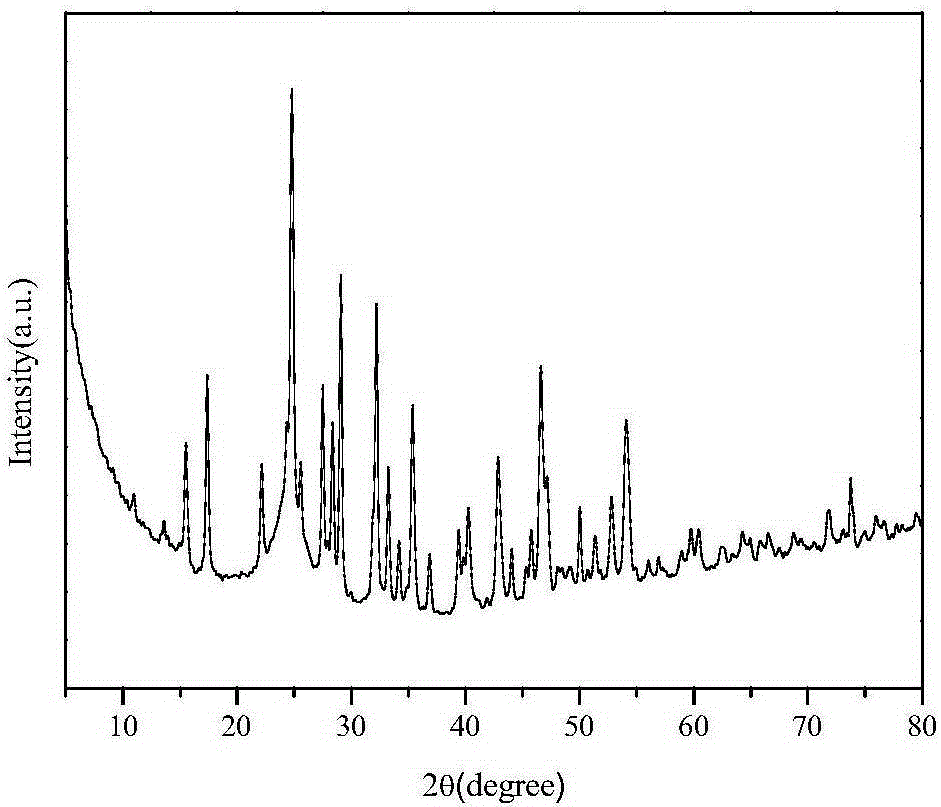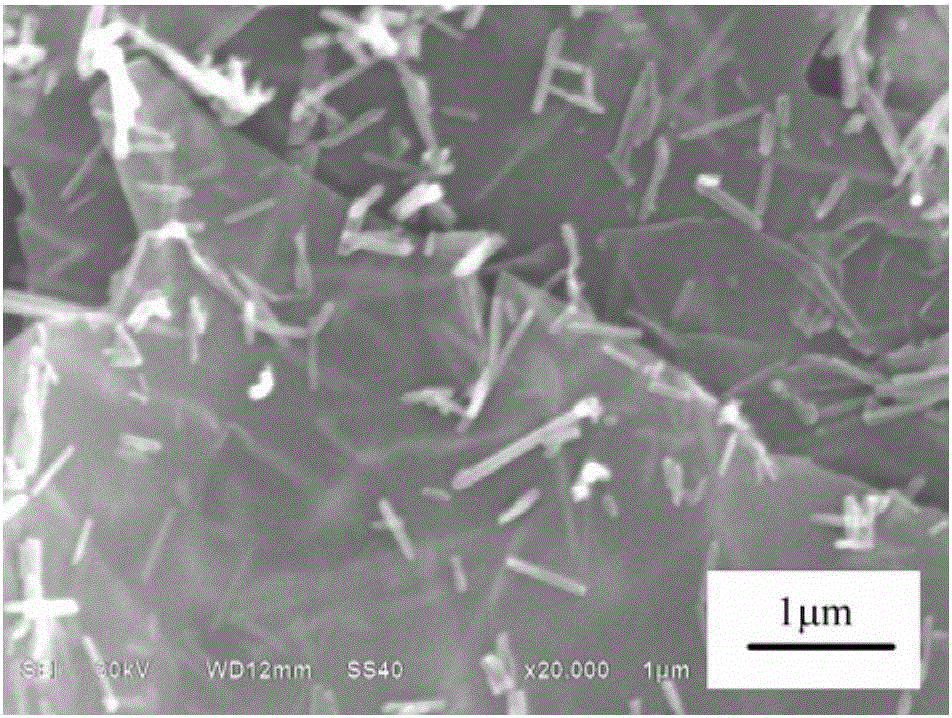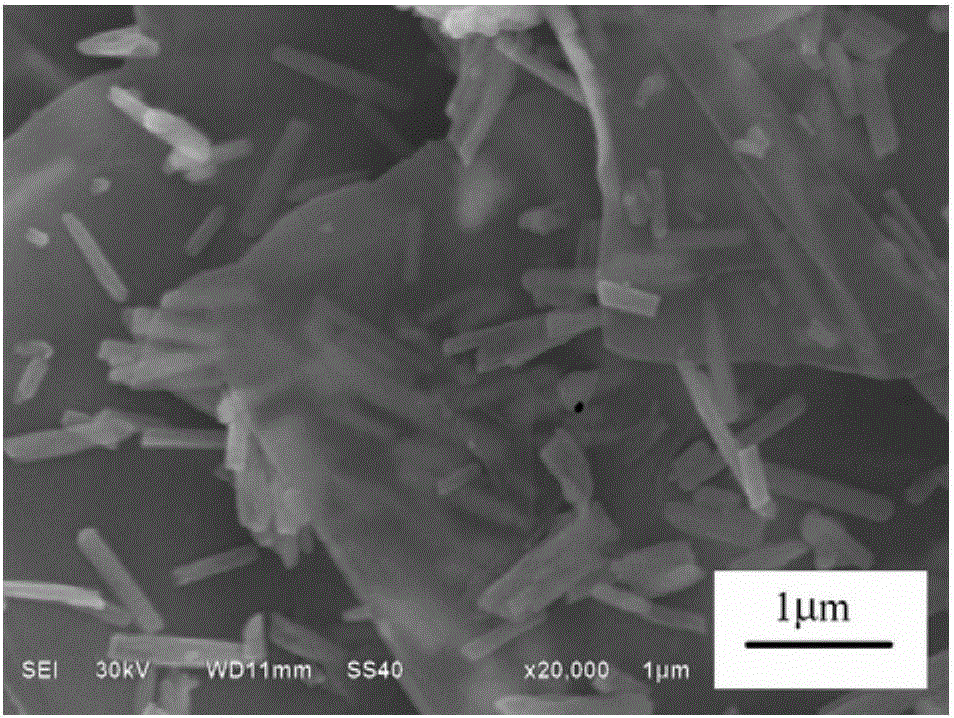Preparation method for graphene and antimony sulphide nano-rod composite visible light catalyst
A graphene and antimony sulfide technology, applied in the field of photocatalysis, can solve the problems of easy recombination of photogenerated electrons and holes, low solar energy utilization rate, and low photocatalytic efficiency, so as to achieve easy control of reaction parameters and easy realization of large-scale industrial production , High photocatalytic efficiency
- Summary
- Abstract
- Description
- Claims
- Application Information
AI Technical Summary
Problems solved by technology
Method used
Image
Examples
Embodiment 1
[0027] (1) Weighing 60 mg of graphene oxide was added to 60 mL of 1,2-propanediol, and ultrasonically dispersed for 2 hours to obtain a 1 mg / mL graphene oxide-1,2-propanediol dispersion.
[0028] (2) Add 0.46gSbCl to the dispersion 3 , slightly heated, stirred to dissolve (SbCl 3With the ratio of the amount of substance of 1,2-propanediol in the dispersion liquid is 1:405), then add 0.18g sulfur powder, the amount of substance that adds sulfur powder is SbCl 3 2.8 times the amount of substance, continue to stir and mix to obtain a mixed solution, which is transferred to a three-necked flask.
[0029] (3) Slowly add 0.56g of sodium borohydride to the mixed solution while continuously magnetic stirring, the amount of sodium borohydride is 2.6 times that of the sulfur powder. Then, it was heated with an oil bath, and stirred and refluxed at 160° C. for 15 hours.
[0030] (4) After the reaction was completed, it was naturally cooled to room temperature and centrifuged to obtain...
Embodiment 2
[0032] (1) 25 mg of graphene oxide was weighed and added to 50 mL of ethylene glycol, and ultrasonically dispersed for 1 hour to obtain a 0.5 mg / mL graphene oxide-ethylene glycol dispersion.
[0033] (2) Add 0.37gSbCl to the dispersion 3 , slightly heated, stirred to dissolve (SbCl 3 With the ratio of the amount of substance of ethylene glycol in the dispersion liquid is 1:550), then add 0.20g sulfur powder, the amount of substance that adds sulfur powder is SbCl 3 3.9 times the amount of substance, continue to stir and mix to obtain a mixed solution, which is transferred to a three-necked flask.
[0034] (3) Slowly add 0.48g of sodium borohydride to the mixed solution while continuously magnetic stirring, the amount of sodium borohydride is 2.0 times that of the sulfur powder. Then, it was heated with an oil bath, and stirred and refluxed at 190° C. for 5 hours.
[0035] (4) After the reaction was completed, it was naturally cooled to room temperature and centrifuged to ob...
Embodiment 3
[0037] (1) Weighing 90 mg of graphene oxide was added to 45 mL of 1,2-propanediol, and ultrasonically dispersed for 3 hours to obtain a 2 mg / mL graphene oxide-1,2-propanediol dispersion.
[0038] (2) Add 0.47gSbCl to the dispersion 3 , slightly heated, stirred to dissolve (SbCl 3 With the ratio of the amount of substance of 1,2-propanediol in the dispersion liquid is 1:300), then add 0.14g sulfur powder, the amount of substance that adds sulfur powder is SbCl 3 2.2 times the amount of the substance, continue to stir and mix to obtain a mixed solution, which is transferred to a three-necked flask.
[0039] (3) Slowly add 0.68g of sodium borohydride to the mixed solution while continuously magnetic stirring, the amount of sodium borohydride is 4.0 times that of the sulfur powder. Then, it was heated with an oil bath, and stirred and refluxed at 170° C. for 10 hours.
[0040] (4) After the reaction was completed, it was naturally cooled to room temperature and centrifuged to o...
PUM
| Property | Measurement | Unit |
|---|---|---|
| Diameter | aaaaa | aaaaa |
Abstract
Description
Claims
Application Information
 Login to View More
Login to View More - R&D
- Intellectual Property
- Life Sciences
- Materials
- Tech Scout
- Unparalleled Data Quality
- Higher Quality Content
- 60% Fewer Hallucinations
Browse by: Latest US Patents, China's latest patents, Technical Efficacy Thesaurus, Application Domain, Technology Topic, Popular Technical Reports.
© 2025 PatSnap. All rights reserved.Legal|Privacy policy|Modern Slavery Act Transparency Statement|Sitemap|About US| Contact US: help@patsnap.com



